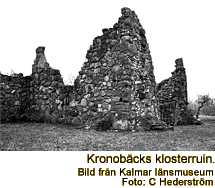Meet the Middle Ages
BackThe Hospice at Öknabäck, the Monastery of Kronobäck

By the thorough-fare along the coast, a hospice - Öknabäck - was built in the 13th century. At the hospice, people who were sick could be taken care of, but above all it served as a guest-house for travellers. People who were on their way could rest and spend the night here. The friars who lived at the hospice took care of the wayfarers and the ill.
In 1479 the entire establishment was taken over by the Knights of St. John. They were members of a religious order which was originally established in Jerusalem at the time of the crusades. The church was rebuilt and became a large convent church. Many other buildings, which were necessary to the monastery, were erected nearby.
Maybe some 15 friars lived here, as well as a number of lay-brothers. The friars had daily sermons and masses in the church, but they also received the ill and took care of them. The St. John friars had a reputation for their great knowledge of medicine and how to take care of the sick. One could say that they were professional nurses. Near the monastery, there was a garden where medicinal herbs and plants were grown. In addition, all kinds of travellers were welcome at the guest-house, rich and poor alike. Beggars and vagrants were also taken care of.
The knights of the order might have visited now and again.
The lay-brothers at the monastery managed all practical matters which had to be done, such as gardening, cooking, woodwork and so on.
The monastery owned around 20 farms in the parish of Mönsterås. There, the farmers paid their taxes to the monastery.
There is a strange memorial stone in the church, dedicated to Sir Laurens Axelsson Tott (not a knight of the order). On the stone it says that Sir Laurens died in 1482. Yet letters, signed by him at a castle in Finland in 1483, still exist. Is the writing on the stone inaccurate, or has the wife of Sir Laurens forged his signature in order to keep his death a secret? In any case we know that Sir Laurens died whilst travelling through Kronobäck.